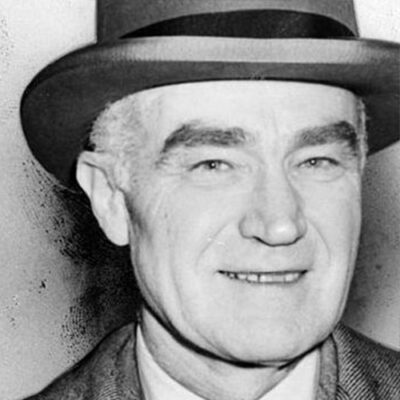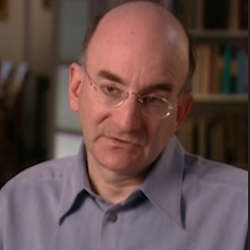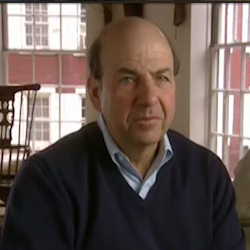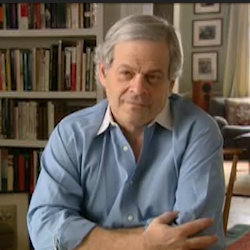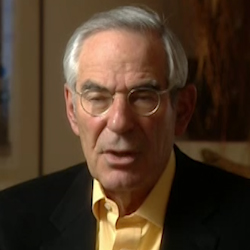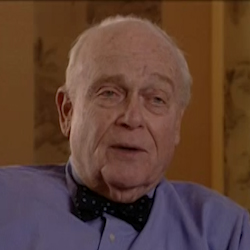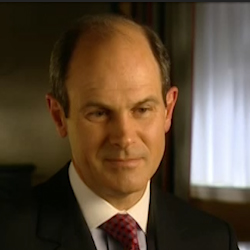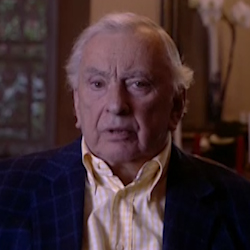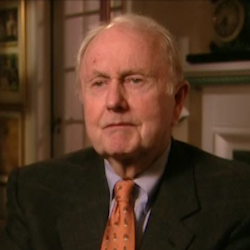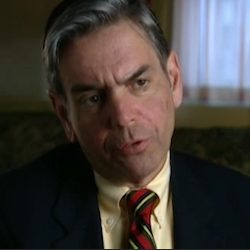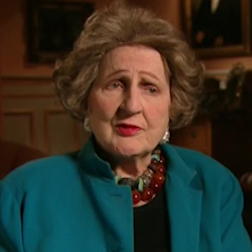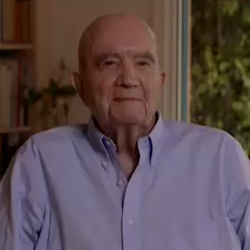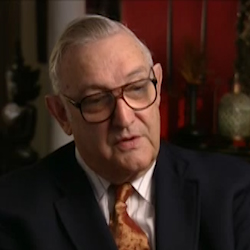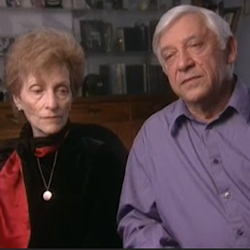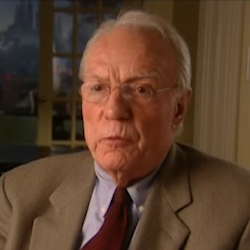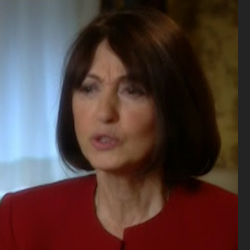Speaker This directive is.
Speaker At least initially, until we get into it, is when you go through the magazines, going to let you know, sort of let you.
Speaker Talk about and do you I mean, look at you are working on your. Okay. I’m trying to get as close to the camera as possible.
Speaker So even though my. The bottom half my body’s over here. If you look here, that’s OK. All right. I mean, if you look off in space searching for a fight or something, that’s fine.
Speaker It really is that where I’m going to find it? You do well, wherever you find.
Speaker OK.
Speaker It is today is February 24th and we are interviewing Erica Dos for Emily Luce in the making of the American Century.
Speaker And I think the first thing I want to ask you is will be a very general question, which is what?
Speaker Important. You think we lose the American cultural and political landscape?
Speaker I think Henry Luce’s importance was that he put together three very important magazines.
Speaker Time then fortune in life a little bit later, Sports Illustrated. And that these magazines contained in them information that was disseminated to literally millions of Americans as well as people worldwide. So I think he was incredibly important as a publisher, but also as a shaper of American attitudes and ideas about themselves, about their country and about the world at large.
Speaker When you. Were younger. Did you? You remember looking at Life magazine, do you remember?
Speaker Oh, yes. We we got Life magazine in my house when I was a child. And I remember getting the magazine and sort of taking it lying down on the living room rug and paging through it. It was it was wonderful to get it in the house on a weekly basis.
Speaker And it sort of became this big book that I spent hours with paging through looking at the pictures, not necessarily reading the captions or reading the small type editorials, but but definitely paging through the visual materials.
Speaker Well, I mean, what was so captivating about it?
Speaker Well, I think it started with the cover, which was, you know, here’s the bright red and white logo of Life magazine in particular. And then the cover, black and white photography or color photography by the by the 1960s, advertisements were were big. I mean, this was a large scale photo magazine. And by the time I was looking at it, those large scale photo magazines had largely disappeared. So this was one of the few that was really left on the market, that sort of juxtaposition between large color advertising and. Great photos of particular events happening in the United States and globally, from rock concerts to the Vietnam War to coverage of the women’s liberation movement to street fighting and Life magazine hired the best photographers, best photographers, worked for Life magazine, was full of their work.
Speaker What about that big Tell me again about the sort of where it would come into the house, what you would what you would sort of go for first?
Speaker I literally would start at the beginning and then sort of put it down, paged through it, open it up and then go through it. I think page by page. But that’s not necessarily the way you look at a magazine. You know, people look at magazines by flipping through. It’s not like a book where you start on page one usually and end up picking a 200, 300 pages later. And so what keeps you with the magazine or what kept you with the magazine was its visual appeal, not necessarily its linear order, reading it from the beginning to the end.
Speaker We’ve got that I mean, the life logo. What about.
Speaker It was different. I mean, even when you compare life with fortune losers, earlier product, this is it’s it’s so much more. Life comes out in November 1936. It’s so much more, I think, about a logo or a present stage presentation style, which is about advertising. You know, it is advertising itself. It is not subtle. So here’s this bright red and this this sort of cherry, orange, red, which they consistently maintained with the white against it is very much about advertising yourself, promoting yourself so that when you look at newsstand shots of all the various magazines that are lined up in nineteen thirties or 1940s America Life magazine, both because of its size but also because of this logo always being placed up in the upper left hand corner, stood out. So it was a way to sell the magazine much in the same way. That time of course was bordered with red. No way to sell the magazine. But I think Luce and the folks who are certainly working for him realized you needed a quick visual bite to sort of appeal to an American audience that was really being pummeled with lots of lots and lots of other visual materials.
Speaker So long as you brought it up. Tell me about sort of the you mentioned you started to mention the the visual of Time magazine. OK. You’re mostly talking about life, right? But as long as you brought it up, what is it about time that that. Well, is there something in the design of time? It’s also.
Speaker Yeah. I think with time it was particularly catchy for its time in that you had a visually appealing cover and then you paged into it with both big page, full page and smaller page ads. But time was always much heavier on text now. But the appeal of that text was that it was choppy and it was 100 to 200 word essays. So it wasn’t like paging through pages and pages, such as in Fortune magazine. Of heavy textual material. It was, as they called it, time speak sentences that were inverted make completely made up words and phrases to to describe.
Speaker Lots of sort of this juxtaposition of important international and national material with the complete trivial. So I think that was part of the appeal, sort of a combination of People magazine and something more serious.
Speaker Can you explain sort of people’s. Love, hate relationship with Time magazine.
Speaker Depends what peoples are talking about. There is a more liberal, though, the more right. I think for a lot of intellectual Americans, liberal Americans, the problem was I would certainly think we cut first because no one was.
Speaker We only sorry, go ahead. Sort of the love hate.
Speaker I think that for a lot of Americans who wanted news to be taken seriously, time was perceived as dumbing down events and peoples in national and international culture. And a lot of people wrote about that. And they also wrote about. And time was beginning to do this and life would really take off on this.
Speaker They also, I think, were fearful of visual culture. There is a sensibility that words were indicative of a higher civilization and pictures were not. And so that magazines that played around with language such as Time magazine or that were more favorable to visual imagery such as Life magazine were in a sense, dumbing down the correct course of American and Western civilization, which was word heavy, text heavy. So I think a lot of people objected to Luce’s empire, at least in terms of these magazines, four percent perceived. My turn to say here, because they perceived that what he was up to was highly manipulable and not the correct path of creating an educated American population or world population.
Speaker Whether they’re, of course, on the other side, there are a lot of people who would disagree with that and say that he, in fact, was doing a lot of education.
Speaker Yeah, I would disagree with that. I mean, I think that the magazine is a lot more complicated. And I think people want to sort of put certain magazines in one pile and time and life in the other. And I actually think that what Luce was trying to do with Life magazine, for example, was to have both an educational vehicle but also a popular culture or entertainment vehicle rolled all up in one. And for folks who can’t accept the ambiguity of that of that new style magazine, this became problematic.
Speaker What was? New and different about life when it first came?
Speaker Well, in a lot of ways, it wasn’t new and different. Its size was coming from magazines that had already been published slightly earlier in Germany and in England. So it was just sort of copying on some of the some of the magazines had already been produced. But I think what was new and different was its audacity and its boldness. Again, this juxtaposition.
Speaker I’m sorry if I may. People don’t know what the previous magazines are. Well, they know. They don’t know what I’m asking you. Oh, OK. You mean instead of referring to it as if you’ll say life. OK. What was you know, it was its boldness. But just that we know you’re talking about. OK.
Speaker All right. And you I mean, to look up at those previous magazines were that Cejudo life was particularly bold visually. Life picked up on all sorts of aspects of other magazines.
Speaker And in some ways, it’s a bigger version of Time magazine, simply a bigger book.
Speaker But.
Speaker The emphasis was on photos. The emphasis was was not simply on the visual material that was unfortune, which consisted of many drawings as well as photography, but the emphasis was definitely more on the best photography that the magazine could hire.
Speaker And what was actually let’s go in. You mentioned the other magazines. Let’s talk with, by the way, if you have this impulse to pick up, just let me know.
Speaker I’m just like, you can just do it, OK? I mean, you just do it, OK?
Speaker And, you know, we have more here. If we don’t if we don’t want to overuse the first one in the last. That’s fine. OK. But.
Speaker Talk to me about what the genesis of life was. OK. Can I can I actually look at the at the book here so I can get the.
Speaker So let’s talk about how life came to be.
Speaker All right. Henry Luce, having created time in 1923 and Fortune in 1930, decided he needed a larger visual vehicle to sort of disseminate his ideas about culture, politics, entertainment, sports, all sorts of things to both the American public and I think a broader global public. And decides in the mid thirties to start putting an illustrated magazine together, modeled somewhat on magazines that were current, were already extant in Germany and England, and proceeded in this country by such magazines as National Geographic, Vanity Fair, and puts together a magazine that was first sort of to be the show Book of the World. This was one of the early titles for Life magazine. And comes up with Life First Issue. November 23, 1936.
Speaker Where do we want to go from there?
Speaker Well, what I want to go from there and we can look at this first issue.
Speaker What was the public reaction to tonight’s?
Speaker It was an amazing success. Life sold out all of its copies. It was so successful that advertising rates, which had been set pretty low in order to entice advertisers to come into the magazine, advertising rates were set too low. And in fact, life wouldn’t turn a profit for about another two years until they were able to increase the advertising rate. So I think the first issue is 400000 copies and it sells out almost immediately. And this continued. So it’s a great success from its beginnings in late November 1936. And it continues to be a great success. And I think one of the reasons for its success here was we look at the first copy with this great photograph by Margaret Bourke White on the cover of several workers at the bottom working on a dam project. One of its great successes, though, is that Luce encouraged America’s finest photographers to work for this particular magazine.
Speaker Now, Margaret Bourke-White had already worked for Fortune magazine, but she came over and became one of the first photographers to be on the masthead of life, which is also something new and different about Life magazine. Photographers went on the masthead, sometimes above the writers at the magazine. So, again, that privileging of the visual does you open the magazine, great full page ads for cars for alcohol, and then this classic two page introduction to the first page of life, which had a photograph on the left side of a baby being born. The camera records the most vital moment in any life. Its beginning. And then a full page introduction by the editor is largely written by Luce himself about what this magazine was to be all about. And this introduction really was followed in both this magazine and in subsequent issues.
Speaker It was a mix, a blend of topics and pictures, presentation modes that sort of all following from Luce’s imperative that the magazine would be both an educational vehicle and a vehicle of entertainment for the American public.
Speaker Keep going. So we’ve hedged through the pages of the magazine.
Speaker The pages of life were thick. This is very high quality paper stock not. And then this is why the magazines are in such terrific shape today as collector’s items. They were very careful to pick the Donnally Company as their printing agent. And they one of the reasons that slowed life up for its initial publication, initial printing, was that Donelli itself had to come up with new inventive publishing printing techniques involving both type and color photographs. Once they perfected that, they were able to go with the production of the magazine. Margaret Bourke-White cover was followed by life’s first article, which was on Montana relief workers making would be on Saturday night, talking about how the Western frontier had been turned into a New Deal sort of economic recovery project with the making of this damn.
Speaker In Fort Peck, Montana, again, aerial photographs that that Bourke-White took employing sort of new understandings of visuality.
Speaker This isn’t a photograph. In other words, being taken from the ground, but it’s a photograph being taken from an airplane. A kind of photographic layout that life would do again and again, showing Americans both the gridded terrain of the western frontier, but also instructing Americans about new ways of seeing not just the nation, but the entire world. Franklin Roosevelt has a wild west. Other photographs of the folks who are in this particular town where people were building that nearby dam, followed by other workers. And then this incredible two page spread cut on the diagonal of the workers partying. We see families, children, moms, dads, workers in a bar scene here at Montana Saturday night.
Speaker Let me ask you something about that particular photo. Sure. Let’s go for a second.
Speaker Just sticking with this first photo essay. What about something like that? It’s the first layout in the first magazine. What about that layout? Would captivate.
Speaker Why that?
Speaker Visually speaking, I think this is going to captivate an audience because of the horizontal angular slash across two pages.
Speaker So it’s different. If we look at earlier magazines, everything is fairly horizontal in terms of its presentation mode. So this cuts across two pages. So it just visually, this is jarring. It’s different. But also when you look at the photograph, many photographs were particularly with with accomplished documentary photographers such as Margaret Bourke White were schooled in that humanistic approach to photography. So she, for example, has folks looking out at us in this photograph.
Speaker Usually I take all of that back because this isn’t a double angle, this is two photographs put on top of one another. Never mind.
Speaker Well, OK, I’ll tell you what, my question is not just about that page spread.
Speaker It’s about this whole photo. Is it right? Why this one?
Speaker What what about this photo essay? Did he did he think that I guess successfully did grab people right from the nose?
Speaker Well, I think that, first of all, the subject. This is a subject of folks building a dam in a town in north eastern Montana. So building the Fort Peck Dam. But instead of emphasizing really workers in the West, this is about making a home, taking the Wild West and turning it into this domestic space, an emphasis on family, an emphasis on the particular how people are living, how they were making their way. This photograph in particular, which shows barbershops and shoe shops, an emphasis on almost the mundane, the everyday, the vernacular aspects of American life. Couple of pages here of some photographs of the dam itself. But again, more about the bars, more about schools, more about laundry. And I think that what grabs the American public and others looking at this magazine in 1936 would be this is a continuation of the documentary impulse of a lot of New Deal photography, with an emphasis on the American people, American places, the daily vernacular living rather than heroic subjects, perhaps workers, etc.. Not that life didn’t do that. But in this particular photo essay, I think what was new and different was that this was New Deal photography now presented within a very accessible 10 cent copy magazine.
Speaker What about Nuti? What is it? So taking it, taking that same plane back. One more layer. What is it?
Speaker What is it about that kind of documentary photography that’s taking place at this time that keeps people interested as opposed to the hero, the big the Ryan Stewart?
Speaker Well, I think that the sort of the documentary imagination of New Deal photography or New Deal visual culture in general is central to the success of life from 1936 for the next couple of years. There is an emphasis in 1930s American culture on returning to and reclaiming and sort of reinventing American culture, American identity, the American nation itself and through the Roosevelt presidency and through all sorts of art and culture projects. The emphasis is repeatedly on the American people rather than heroic leaders. The things that people do in their everyday lives. And that’s what this magazine captured, not completely and not entirely, because it would go back and forth between these sorts of articles on the folks building the dam in Fort Park, Montana, to the next couple of pages, which are both life on the American news front in Washington, in San Francisco, in Louisiana and Philadelphia, in olma Wisconsin.
Speaker And I see here and then also worldwide, sort of an international political focus.
Speaker So there was really this attempt in the show, Book of the World to do it all, do the American vernacular and do the global scene as well and bring it to a particular level of accessibility to what was perceived as the average American reading the magazine.
Speaker I mean, the middle the middle essay in here, the president’s album is literally sort of a scrapbook. Photographs of of FDR and various other members of the cabinet and the presidency laid out exactly like a typical scrapbook. Note that the photographs are tilted and they’re framed in white, much as one would put them into your. Your average scrapbook.
Speaker I think this gave it sort of a folksy, easily identifiable feel to people who are looking at the magazine.
Speaker Now, one thing about life that was also unique was its favoring or patron patronage of American artist. So the very first issue of Life magazine features several pages of works by then popular American regionalist painter Jon Stewart Currie and photograph of Currey here on the left, and then photograph photographs and reproductions of his paintings and his drawings, which corresponded more or less to these photographs of the American people that Margaret Bourke White is is capturing tornado over Kansas here. Line storm photo paintings of Wisconsin countryside, paintings of Kansas tornadoes, paintings like the photographs that were very much about the American people in the nation, as it understood itself in the 1930s.
Speaker That motivates you.
Speaker What was it that motivated Lewis to. Emphasize, as he did in this and subsequent issues, Art. Why what why did he think that would be something that would that would help sell his magazine or that is his readers would be interested?
Speaker Right. I think Lewis understood Life magazine to be something that would instruct and educate. This comes right out of the mission statement.
Speaker Which would be great to to read or think about at some point to instructor educate. And he really considered visual arts, both foot photography, but also paintings, drawings, et cetera. As a prime vehicle of this sort of mode of of education, I think what’s important about Life magazine is that it is this terrific blend of this emphasis in the 20th century on visual culture as an educational as an instructional mode for the American public. This is a this is a magazine that is very much about utilizing the visual in order to instruct teach Americans about domesticity, about family behavior, about politics, about entertainment, about all sorts of activities and enterprises in order to create or construct a normative American population. And I think he and the folks who worked for him at Life magazine and the other magazines really believed that the American regionalist, for example, of the 1930s were on the same wavelength with the entire enterprise that let loose was up to, again, instructing, educating, teaching Americans about themselves and sort of shaping and directing Americans for the future.
Speaker What do you mean by normative American population?
Speaker I think that Luce and I and others had a had a understanding of the stereotypical or typical American, which was middle class and understanding of the American nation, which was very much about democracy, capitalism and corporate capitalism in particular, and that the average American family, whether it was white or black, because in the 1950s, you really see Life magazine embracing understandings of integrated America, that the average American family would be homogenous, would be in.
Speaker Christian believing in democracy, et cetera, et cetera. So I can see that better.
Speaker We’re waiting. All right.
Speaker Thank you.
Speaker I think when Lewis was putting the magazine together in the mid 1930s, that he recognized that the country was in crisis and that this magazine, as much as Roosevelt’s politics, could greatly help the American nation and the American people stay together, stay unified. The magazine then becomes in the 1930s and certainly through the 1950s and 1960s, a vehicle that is very much about unity, a vehicle that is very much about sort of teaching its audience about what Luce and others at life felt were appropriate manners and behaviors in the public sphere as well as at home.
Speaker And I think that as a highly moralist individual, he felt that this was his that this was his moral obligation, that there was almost an imperative of the magazine not simply to get the information out there, not simply to have lots of beautiful photographs and to to to be a patron of American artists, but actually to use those visual materials in ways that would shape and direct the American public.
Speaker That was a little bit more coherent. Let me put it this way.
Speaker What else do you want me to say about this first issue? You know what?
Speaker You want me to think that one of the things that strikes me about the first issue is there’s this. Close to the end. This is advert where they do the photo Cribbins, right?
Speaker Which I found.
Speaker Actually, you know what I wanted to talk a little bit about the analogy goes to people, okay.
Speaker Let’s get some good ads about the Chessie ads.
Speaker Might find some stuff that’s about consumerism.
Speaker Life’s ads in the 1930s and through the 1950s, often full page ads in color.
Speaker Helped convince its American middle class audience. Of all the goodies, they were out there for consumption. So we have a NASCH for 1937 ad here for only seven hundred and fifty five dollars. The ad itself is it’s sort of visually a mess, but there’s type at the top.
Speaker The face of an individual here, Nasch himself. And then the car. And I think what audiences would actually zoom into would be not the talking head, not the text, but this red car image right in the middle of the page. I mean, very carefully placed. Then you move throughout the rest of the magazine. And there’s sort of this this, again, juxtaposition between advertising and photographs so that often it’s almost as if you’re incapable of making the distinction between the advertisements and the text and imagery of the magazine itself. And I think, you know, this is almost commonplace today. We watch television, we look at magazines, and it’s very hard to make those kinds of distinctions between mass media advertising and the text and imagery of the of the magazine, the the book itself. But this was this was fairly innovative in Life magazine. Fortune, I think, makes much more of a distinction between this is an advertisement and this is an article in Life magazine. We begin to see a blurring of distinctions between these cultures.
Speaker It almost becomes is that an is that an ad or is that an advertisement sort of game that you play as you page through the magazine?
Speaker Well, the.
Speaker So you.
Speaker OK, interested that a good indicator of life’s obvious privileging of the photographer is given on page 72 of the first as a first issue, where Margaret Bourke-White is featured at the very top of the page in a very small photograph showing her with her camera. There’s a short couple of sentences describing her notable contributions to candid photography, which bring elements of design and composition without loss of spontaneity and naturalness to the overall presentation of the magazine. This is followed by a list of the photographers involved in the pictures that are included in the magazine and at the bottom of the page. On this on the bottom second half of the page is an advertisement and says advertising in small, small letters here, gangster’s moll captured in Iowa. Another example of a picture that has help. This is an advertisement for the Des Moines Register and Tribune newspaper in Iowa. An example of how pictures are helping to sell the magazine. Pictures have helped build the Des Moines Register and Tribune circulation to more than 300000 on Sunday. So this is a great example in this particular page of how the photographer’s privileged at the top. And then an advertisement from a newspaper emphasizes the pictorial privileging at the magazine. And even better example is the advertisement for Young and Rubicon advertising on page 81, a very powerful photograph with the word impact at the top and then a person being hit in a boxing match below, taking up about half of the page easily and then very little text at the bottom. Not a lot of type. Emphasizing how Young and Rubicam is also an advertising agency that will privilege the visual. So, you know, I think a lot of what the magazine is about at this point, when it first starts out, when it continues, is. Privileging the visual teaching Americans about visual culture as a source of information, as a source of education. Using articles that are instructional and mixing and blending those with pleasurable ads and sort of mixing up instruction and pleasure at the same time.
Speaker If you go back to that Des Moines in one of the things that strikes me about it is my first look down because it has a headline. I thought that was an order.
Speaker I wonder if if it strikes you as that, first of all, and whether, again, you could talk about that, as you know, as you say, this kind of blurring of the, you know, what’s advertising, what’s what’s what’s a pictorials, let’s say, in the movies.
Speaker Right. Well, this is coming from an article. This is an article about the capturing of the desperate Barrow Gang. And although it looks like a staged photograph with all the folks around here.
Speaker Police detectives, et cetera. But it is also an advertisement for the power of this image in this particular newspaper.
Speaker There is confusion that’s going on for the reader of the magazine, particularly when you look at this image and you miss the small type for the word advertisement. And then you go back to the photographs that are actually in the earlier pages of magazine, which are the same tonality, the same black and white visuals, the same framing of the dramatic. And so in a sense, although the magazine is very much about instruction, instructing and educating the reader, I think the reader also is confused as to what the distinctions are between real life, real world and advertising and advertising. And increasingly, life in subsequent magazines would turn to the photograph in their own advertisements rather than drawings.
Speaker So it all becomes one big blend, which has one effect.
Speaker I think the effect to a large degree is that it normalizes consumerism or naturalise as consumerism. It also makes it very difficult for us to, as audiences to understand our make our own distinctions between the real and the staged, the spontaneous and the posed.
Speaker And I think that’s a big problem today.
Speaker That we don’t understand aren’t capable of making those kinds of distinctions, which when you add onto it as well. The trust that we tend to have with photographs. You know, there’s this sensibility in the 1930s that photographs are direct evidence. They are truthful. There’s a sense in which photographs are veracity itself. And yet we’re also very smart about knowing the ways in which photographs are used in advertising purposes.
Speaker So it helps to make advertising real believable and to put it into the realm of the real and believable.
Speaker Of. Documentary photography.
Speaker If you’d closed that from Major. Altogether, again, as I said, a little closer to you.
Speaker I want to ask you about some of the other time features, because you were talking about sort of this normalizing this instructor. Tell me a little bit about. For example, there is this I mean, there’s a zillion famous photo essays, but.
Speaker Certainly. Life goes to a party. It was a big feature. So tell me about sort of the choice of having that be a regular feature in what? What the impact of that is on people who used to get the movies.
Speaker There were several regular features in the magazine and Life magazine. Perhaps not every week, but but often enough so that they were considered regular features. Those regular features were speaking of pictures, which was often a two to four page spread of innovative photography. And also life goes to a party and life goes to a Party was a feature that appeared once a month, if not twice a month at the magazine. And it would take Americans and it would take life readers to parties. And some of these parties were absolutely banal and other parties were taking place in France or Monaco or India. So there was a big spread of parties. And I think that the reason for this was to show Americans about behaviors and modes of behavior in different class situations. Middle class, upper class royalty, but also simply to let Americans in on the exotic other. So a lot of these parties, for example, took place in India or Siam and royal weddings or religious rituals, et cetera, became the stuff of these particular parties that you sitting in your middle class home in in Hoboken or Des Moines or San Francisco are now a part of. It’s almost as if you have an invitation to these parties as well. This was life’s way of breaking down the world, bringing the world into your home, but also bringing you into the world. And there there’s almost a sense of ownership then. If you read the magazine that you also were entitled to or had buy in to this larger global imperial vision, that loose head of the world out there.
Speaker How did. How did the same. I don’t know how to put this.
Speaker How did it use sex or what was its relationship to sexual imagery and sex? How did he use sex to sell his magazine and an.
Speaker And was that a conscious choice?
Speaker I think it was a conscious choice. And I’m not sure it would be sex so much as it was pretty girls and pleasing bodies, and those could be both male and female.
Speaker Let’s start over. Okay. So thank you for straightening. But let’s start off by saying, you know, wife. However, you want to say it’s perfect for using pretty girls, pleasant bodies, male, female. OK. From there. All right.
Speaker We know life was definitely in tune with the selling itself. And one way that it sold itself as a magazine was through the presentation of Pretty Girls on its cover, such as this. Kim Novak cover from March 1956, but also filling the magazines with with pleasurable bodies, both male and female. So I think that that it wasn’t necessarily sex or sexuality. This wasn’t Playboy magazine, for example. But but certainly the healthy, well-fed American starlet was prominently featured generally every other cover on Life magazine.
Speaker And and how did he figure that was? Good help sell the bags.
Speaker Well, again, I think we need to be cautious about crediting loose with all of this. He’s got a large staff. He’s got editors working for him. But I think that certainly at this time period, much earlier, of course, as well, sex sells. But again, this wasn’t sex. This was good looking girls airbrushed. I mean, all the covers were airbrushed, presented as new stars and new starlets. Early Marilyn Monroe, for example.
Speaker And how did they come to that?
Speaker Simply the idea that sex sells.
Speaker Some people accuse the magazine actually of having too much of a link to Hollywood and being used as a promotional vehicle for Hollywood stars.
Speaker Nothing much has changed, I suppose, in that regard.
Speaker What about as a political extreme? What was his political agenda?
Speaker I think life’s political agenda was much more to the point to parallel Luce’s political agenda. Whatever Luce’s particular politics were were carried through in Life magazine and Time magazine. So he was not particularly favorable about Roosevelt in the 1930s. And he have to be careful, or rather, the magazine and other staff had to be careful about the presentation of Roosevelt because he recognized that most of America was pro Roosevelt. So he in the President album, in the first issue, he juxtaposed a juxtaposes the photographs of the president in the Presidents album, but doesn’t lampoon him, does not present Roosevelt as a figure of caricature. I think he’s very careful about that. By the time we get into the late 1940s and 1950s, the magazine is obviously part of a cold warrior mode of politics. Articles about communism are presented. Life actually goes sort of in and out of an up and down in terms of its understanding and rejection of communism. But I think the magazine is very much in league with Henry Luce’s ideas about foreign policy and about about the nation, about the American nation itself, how it should present itself, what sort of attitudes it should have, how it should be a global leader.
Speaker Also, the composition of the two negatives. It’s fine. I mean, that’s OK. It’s an exact match, obviously. No, I’m not looking for a match. Looks good. That’s good. Hey, let’s talk about World War two and the relationship. I’m sorry. The relationship between life in World War Two. How did.
Speaker How did they. Help each other’s mission. Took a question.
Speaker Not having any World War Two in front of me. And what did the magazine did for World War Two?
Speaker He gave a real boost. And there’s sort of this reciprocal relationship in terms of Life magazine’s role in.
Speaker As a kid, I use this term guardedly propaganda tool for the war as well. No American government.
Speaker Life magazine played a huge role in terms of the dissemination of information about World War Two.
Speaker Now it was restricted from publishing photographs of battles and particularly of American war dead for the first several years of the war. But once the military folks in the government recognized that come sooner or later, the United States would win out in this particular war, life was able to publish battlefield photographs and took a leading role in this regard, sending multiple life photographers into battle, several of whom lost their lives, but also hiring American artists to join troops and create drawings and paintings of what they saw. And Life published this almost in every issue. During the war years. So again, Life was the picture book of World War Two in much the same way that the newsreels march of time. We’re also presenting that sort of information. But this was static rather than in a movie theater every week. I think it played a very important role visualizing the war and.
Speaker Doing so again in an affordable, accessible manner. I don’t know if you’re going to talk about the pass along rate at some point or how popular the magazine was, but one person might buy the magazine in 1943, but it could easily be shared with 10 to 15 others. There was an amazing pass along rate to depending on the circulation that the magazine might have had, eight to 12 million a week. For example, the magazine might be passed on to many, many more millions of Americans at beauty parlors or barber shops or doctor’s offices or simply in the average American home where it didn’t just come to one person.
Speaker It would go to eight to 10 others. The magazine during the war picks up the high circulation that it would maintain throughout the 1950s. It really becomes the magazine to look at. Get this visual information from during the war years.
Speaker The first photo of war, did you talk about the restriction? Was that George struck for three men on the beach? Right. What was the what was the impact of that photograph?
Speaker Well, the public.
Speaker I don’t know. OK, but I do know that later the impact on folks like Gordon Liddy was to Gordon Liddy looked at that photograph, must have been later and said that had hardened his resolve as an American. So the impact of the photograph was pretty tremendous.
Speaker Go back and tell me that again.
Speaker Can I just just let me get this right. Describe to me as a talk show host, doesn’t he?
Speaker But I don’t have to say about it. Right.
Speaker These all the north together.
Speaker There’s no doubt that life’s publication of wartime photographs was instrumental in shaping American attitudes about the war and about America itself. Gordon Liddy, involved in the Watergate scandal of the 1970s, recalls looking at the photograph by George Strock of American War Dead and recalling that it hardened his resolve as an American.
Speaker Whatever that means.
Speaker In what way, if at all, do you think life? Transformed the report, reportage of war.
Speaker I mean, was it did it, was it? Yes, that’s the question.
Speaker Brian. I know that life was privileged among other newsmagazines and other forms of journalism. Life had such a reputation by the early 1940s that the military was very willing to allow life to become its own sort of propaganda instrument. So in that sense, the magazine wasn’t simply fed information from the military, but it was actually allowed to shape that information so that the magazine would go on flying missions with members of the Air Force and was onboard during battle.
Speaker It had a symbiotic relationship with the American military during the war. That is certainly the case during the Vietnam War as well, although that is different because of the use of television during the war. But magazine photographers, again, were with soldiers and again, many of them died during the Vietnam War. During the course of battle.
Speaker After the war. What role did. Life. Play in creating a.
Speaker Kind of an American self perception. A new.
Speaker Perception that after these 20 years of her fifteen years of depression or hard times, how was it a part of the post-war boom?
Speaker Because life’s peak years of popularity and influence are really in the years following World War Two. And throughout the 1950s. And I think that that is substantiated in a typical Life magazine. This one from March five, 1956, featuring a pretty girl on the cover. This is Kim Novak as a starlet. And it’s and it’s sort of realized in the entire spread of this magazine, which has one hundred and eighty four pages, a fairly large book for the time and is full of advertising text.
Speaker Editorial’s. All sorts of information about the typical American family or what Luce and others at life were hoping would be the typical American family and the typical American nation. So we start the magazine with an ad for Crest toothpaste on the left side.
Speaker In an ad for Philco products from television to refrigerators to air conditioners on the right, we continue into the magazine with full page advertisements for telephones. The mast over here index over here, which again has the photographers listed tombs of all of the photographs that they’re supplying here. And we continue into the magazine pages and pages of full page ads. Canada dry lots of insurance ads, full page bra ads, lots of ads for consumer products for women. Women being the pocketbook of the American household. The magazine is absolutely cater to their consumer taste and preferences, both personally in terms of the domestic sphere here, dishwashers coupled with pearls, refrigerators, car insurance, letters to the editor on one side, big page ads for various. Fast meals that the typical American housewife can make. Here’s a three minute cheese sauce. Full page ads for beauty rest mattresses. I mean, all of these things that we can buy as Americans in the 1950s, if you’re of a middle class household. Shoes, watches, cars, new Dupont, Dacron fabrics. Here’s one of the typical life features. Speaking of pictures, a two page layout of a lion hunting down something to eat, followed by a big full page color advertisement for SEAL test ice cream.
Speaker Beautiful visuals, wonderful pinks and raspberries in this color. And then hiding off over here, a form fit bra advertisement. I know lots of young boys who page through the magazine the 1950s because it’s like National Geographic did have images of women that you would never find elsewhere.
Speaker Carpeting, Glass said, setup for the server, which is getting close. Did we? It was OK for the last thing, it was audible. I think I want to see that. All right. Do you remember where it was?
Speaker There we go. Yeah, they’re outdoors, too. The ones outside.
Speaker Yeah, look close.
Speaker Yes. It’s gotten New York in the background so silly.
Speaker Do you tell us about teenage boys?
Speaker I know so many teenage boys who who learned about female bodies on the basis of both looking at life magazines, bra and girdle ads and, of course, National Geographic.
Speaker I don’t want to go any further. All right. Let me hold it open or. No, that’s OK. OK. Continue to pick. Continue. All right. All right. Adds ads for four. I just thought that. Everything OK? Please. All right.
Speaker And back to your to your question about how does life in the post-war era help?
Speaker Teach Americans about normative nationalism and sort of, you know, typical behavior. The very first article in this March 1956 issue is on the golden youth of communism. So on the one hand, life was, of course, staunchly identified with with the Cold War Cold Warriors anticommunism. And yet this particular article humanizes the Soviet people.
Speaker The golden youth of communism humanizes them in the presentation of articles and in in the pictorial forms of communism itself is the threat the Soviet people are not. And there is the presentation of the Soviet people as being just like Americans here.
Speaker They are fixing their lunch. Here they are at work here they are at parties. And very much like the presentation of American behaviors throughout the magazine, life would do this back and forth, humanizing the enemy. But definitely we have this enemy called communism. This is to pit four page spread on the Montgomery bus boycott from 1956. And I think life played a very important role in the 1950s with educating Americans about the necessity of integration. I think claims have been made that life was very much about a white middle class. And I tend to disagree. I think that in the presentation of of articles and visual images such as this four page spread, there is evidence that life was deeply engaged in encouraging the American public to be supportive of integration on liberal terms. Life did not support radical moves for for ethnic and minority representation, but nor did it nor did it support the status quo. So this is a very important presentation of the Montgomery bus boycott with a small photograph of the very young Reverend Martin Luther King here on the right page. Next to that photograph is a photograph of the arrest of Rosa Parks folks in Montgomery. Cheering on the bus boycott, which went on for months. And then a very important photograph of of blacks in Montgomery on the steps of the Alabama state capitol. So a new show of unity in historic setting is the type for this four page spread. Clearly, Life magazine is playing a role in encouraging Americans to be supportive of integration for reasons that I think have a lot to do with the creation of a middle class consumer market, a middle class in which a rational middle class. It doesn’t matter whether they’re white or black, but they’re all engaged together in important issues of democracy, the work ethic, Christianity, etc., rather than fighting amongst themselves over issues of race.
Speaker Many life magazines of the 1950s featured an editorial fairly early on in the book. And then on the opposite page was Campbell’s Soup, big color page ad for Campbell’s Soup. Here we have tomato soup. Dick Stoli talks about how Campbell’s there’s been a lot of discussion over what was the interplay between advertisers and the magazine itself. What sort of weight, what sort of power did advertisers have in terms of placement of their ads and next to what sorts of articles?
Speaker We can’t really answer that question, but it is evident that Campbell’s Soup Campbell’s had a position of power because it was so frequently placed right next to the editorial page in the middle of the magazine, which would give it a certain credibility in the magazine and also make it familiar. When you turn to the editorial, there was the Campbell’s Soup. And so Campbell’s becomes a part of this magazine on a regular basis. Two page ad here for Panamerican, a Norman Rockwell ad, pretty good example of his work in advertising from the 1950s. And then the magazine continues again with this juxtaposition of articles and advertising. What’s interesting about this particular issue is a long letter to the North from American writer William Faulkner, in which he basically warns on integration, which is the title of the article, and encourages northerners to go slow with integration. But they make it very clear that this is from Faulkner and not from Lewis and not from life itself.
Speaker One, you think? Do you think doing that was a way to sort of keep its Southern readership?
Speaker White Southern readers.
Speaker I think it’s a way to to make sure that there is a distinction between what Luce and life has done in just a few pages earlier with their demonstration that the folks in Montgomery, Alabama, are is entitled to full rights of citizenship as everybody else in the nation. But to also give voice to southerners, but not to entirely give them power within the within the space of the magazine. You know, this is a letter to the north. It is Faulkner writing on the next page. It’s signed by Faulkner and isn’t endorsed. In recent weeks, disturbed by the violence arising out of Southern resistance to integration, he has written this personal subjective document, a warning letter to the North. You know, I think that it’s publishing the material, but it’s also framing it in such a way to make it very clear that this is from him and it’s from the south as opposed to loose in the north. And the careful framing might be to avoid losing Southern readership. Southern advertising dollars. But I’m always amazed when I see this kind of coverage from the mid 50s that that that might that mustn’t have been the overriding concern because life went ahead with this consistent presentation of integration as the thing that America must pursue in relation to.
Speaker Mm hmm.
Speaker They did that. What was the significance of the big multipart series on segregation?
Speaker Life does a very important five part series on segregation in the South in 1955 and 1956. The latter two issues featured photographs by Gordon Parks, who was the first African-American photographer to be hired at life in 1948, and he stayed with the magazine until the early 1970s. The significance of the of the five part series was, again, to to instruct its readership about the real tensions and dynamics of race in America, but also to encourage them to recognize by the end of the five part essays that the five part series that integration was going to happen. Segregation was something from the past and there were right ways to do this and there were wrong ways to do this.
Speaker You you pay.
Speaker OK, so let’s take a look at these car ads and how important they are to life.
Speaker During the 1950s, when life had its peak circulation, it also had its peak advertising. So here is a terrific example of how advertising was so important to the magazine and really helped its audience become familiar with the latest products. You know, Life magazine was the vehicle where cars, refrigerators, air conditioners were introduced to the American public and presented as these enticing items which the average American middle class, upper middle class household had to have.
Speaker Here’s a terrific spread on Chrysler cars from 1957. The two page ad for the Plymouth with this car about ready to roll right into my lap here, being driven by a woman. And I think that’s important. Again, women as the primary consumers or at least in charge of the middle class. Middle class consumption in the home in the 1950s. So here’s a woman, very tiny woman in the midst of a very big car driving it right off the page, followed on the next page by a slightly different presentation of a of a 57 dodge, taking up two pages with the car dealer, aerodynamic presentation of the car, information in the background, a couple, yet another 57 DeSoto with folks partying bright reds, visually dynamic presentation of material. And the emphasis in these ads is on the pictorial. Yes, there’s information below, but the emphasis on the ads is definitely on the image of the automobile itself. This ad for the 57 Chrysler folks in the city going to parties takes up easily. Two thirds of the stubbles spread. Here we’ve got a imp.. We don’t even need people at this point. It’s been embraced entirely by the American Eagle with the red, white and blue ribbon. I mean, this is what you needed to have had to have. If you were to be the typical normative American in the 1950s, long spread the use of color rash.
Speaker Right. Right.
Speaker These colors are terrific. And then I’m always surprised when I look at the magazine from the 1950s, although I shouldn’t be to go from the red and white logo with the red band on the outside into black and white, an amazing color photography in the advertising. Bright Maroons, red and white, more red and white here. This great juxtaposition of a bright red yellows and then this two page of yellow.
Speaker And so even looking at these magazines. Forty five years later, the colors are still of right. Vibrant, still very, very bright. And I think that in terms of visual culture in the mid 1950s before color television and yes, people are going to the movies where there are Technicolor films, et cetera. This is visually appealing and we think of it. I mean, this is really where color is being presented to the American public in the magazine form.
Speaker Television at this point is all black and white. Tell me more about. And you’ve touched on it here.
Speaker The role of women as portrayed in life.
Speaker OK.
Speaker Life actually did some special issues on the American woman in the mid 1950s, and life recognized the importance of appealing to a consumer base that largely dictated how money would be spent and in the household life, also recognized the growing power of women’s liberation movements. Demands for for equal rights going on in the 1950s, concurrent with civil rights movements to life, did give credibility, presence to the representation of American women or women in general. But life also putting pretty girls on the cover emphasized the, you know, the body of the American woman did a lot of fashion spreads. Interestingly enough, Gordon Parks, hired at Life magazine, went back and forth in the 1950s between doing fashion spreads and articles and essays about civil rights. So it sort of back and forth between these two dimensions. So here’s a fashion spread here, accompanied on one page. Here’s a fashion spread on the left side and on the other side, an ad for US secretaries. Sort of voice recorder at the top. We’ve got five little pictures of the secretary talking about her boss, talking about instruments that would make her life more efficient. And then the next picture of long spread is of the secretary. Oh, she’s a mom and she has two children here. And then there’s a picture of the the voiced writer itself. The juxtaposition here of fashion, the presentation of clothing with working women helps to sell the magazine as a whole to two female audiences. I think trying to get to the Kim Novak piece here. Ads for ads for food were clearly oriented towards the typical American housewife. Here’s a two page spread with Heinz tomato ketchup being used for a variety of tasty meals. Ketchup in desserts. I think I’ll just turn the page. Then a long article towards the end of the book on Kim Novak, a lovely girl tries to catch up with a runway runaway career. We see a photograph of her sandwiched between her two agents as they’re discussing her prospects for a career in the films. And then lots of photos of her at her home with her mother during acting tryouts, etc.. This is a good example of how life presented the American woman, at least in longer articles like this, as a real person with a family, with family dynamics, with friends, etc., that also presented that American woman who was beautiful, presenting her in gorgeous clothing, in dramatic roles, et cetera. So this back and forth.
Speaker Was it necessarily propagating a particular role, was it trying to keep women, quote unquote, in their place or were not really?
Speaker Did it have a political stance in terms of women’s issues?
Speaker I don’t think we can read it that directly. Did life try to keep women down? Did life try to keep women in a particular place in these 1950s pictorials? I don’t think so. I think it’s more complicated than that. Sure. There are essays and pictures that that would present the American woman with half a brain and simply making lots and lots of meals with tomato ketchup. But then there were other pictorials, essays, photographs and even advertisements that went beyond that simplistic presentation of the American woman and sketched her as a more complicated citizen in the nation.
Speaker One more question about some of these ads, didn’t life didn’t Harry Luce run into some trouble with all his liquor ads?
Speaker I noticed as you went through when we saw one of liquor ads and you don’t even necessarily have to find one to talk about.
Speaker But is that something that your readership is churchmen? Right.
Speaker I am not aware of it, but I was struck by an ad and one of these four and I don’t know where it is from the American Brewery Association, in which they were saying beer and ale are America’s drink support, America’s drink of moderation. So I was wondering if there had been some sort of temperance movement in the mid 50s. I wouldn’t be surprised that people would object to these full page liquor ads in here. On the other hand, full page liquor ads helped pay for the magazine, and they provided the funding as much as the double page or full page car advertisements, bra advertisements, canned ham diemen, you name it. All of the consumer stuff of the 1950s is represented in the magazine.
Speaker What about and you touched on this earlier, what about life as a cultural artifact? I mean, what. What is it about life that that continues to fit the fascinated people, that continues to fascinate them?
Speaker Life has become a cultural artifact, sort of a historical memory. We see it popping up the cover with this distinctive logo and its red band at the bottom in all sorts of movies over the past 20 years or so. Toy Story two. Forrest Gump is a good example of how life popped up as sort of a historical thread in that particular movie. People today often buy copies of the magazine from the week of their birth. Baby boomers especially. So in that sense, the magazine itself has become almost a signifier of then of history, of historical or even biographical memory. What’s inside the magazine to get beyond simply the cover with the date? What’s inside the magazine is not only historical memory, but a good indicator of an America that a lot of people wish for. Wish we could return to. Some people feel that life is a very simplistic document and the one we hold up a copy, we sort of reference the easier or less complicated times of the 1950s. But in fact, when you open the magazine up and you look at the juxtaposition of advertising and articles and you look at how the magazine is trying to present a more complicated American nation and country in the 1950s, a nation about integration, a nation that attempts to give autonomy to two women, you realize that life is engaged in a far more complicated presentation, an understanding of citizenship and American democracy possibilities.
Speaker Would it be fair to say that? That life is also sort of looked at as a kind of historical scrapbook.
Speaker Oh, very much so. The historical scrapbook idea, I think, is very resonant with with people’s looking at Life magazine. I know people who sort of grew up cutting pictures out of the magazine and reframing them and turning them into art projects, for example. I think I think the scrapbook metaphor is good for us today. We look at life today and sort of look at it as this historical document or historical artifact of a particular time. But I think what we have to realize, too, is people looked at this magazine casually, seriously. There are many ways of looking at the magazine when it came out that week, when it came out and then tossed it away. This wasn’t this wasn’t the kind of thing that you necessarily kept. Magazines are very ephemeral. Magazines are simply of the moment. And you look at magazines on the bus or on the subway when you come home from work. And these are very casual, almost spontaneous moments. But nevertheless, through these spontaneous interactions with the magazine. The magazine.
Speaker Had incredible power in directing, shaping, instructing its audiences about everything class, race, gender, the world outside technology, the space race, foreign policy of life head.
Speaker Incredible power, particularly during its moments of high circulation and lots of advertising in the 1950s especially.
Speaker What about the. So called. Big acts. You know, the.
Speaker Ten part series on the ethic of man. The you know, the history of Western culture or modern or these sort of grand.
Speaker Um, uh.
Speaker Well, these grand presentation. What? What do you think, Father, like to do that actually without having to leave? OK.
Speaker This is America’s Arts and Skills, Part eight. All right. Life frequently had series articles. Winston Churchill. Had quite an industry in publishing, lots of his biography in the pages of Life magazine. This particular issue with Kim Novak on the cover is about America’s arts and skills. It was a way of presenting America’s material culture to American readership. Again, I think this was almost an Encyclopedia Britannica approach, using bits of the magazine to almost write encyclopedia articles and feed that information to a readership. I don’t think it’s something that the magazines particularly remembered for today. What we remember are the covers, the juxtaposition of ads and articles, the photo essays by some of America’s best and most accomplished documentary photographers, Jean Smith, Margaret Bourke-White, et cetera. But I think that these series Arts Series, Culture Series, Foreign Policy Series, many of them very text base, were we’re feeder’s both for the magazine and definitely indicative of Luce’s educational impetus with the magazine to educate Americans about particular incidents, episodes that he thought were important or is his his staff thought was important.
Speaker Why do you think life went out of business? What happened, what contributed to the demise of Life magazine?
Speaker The demise of life.
Speaker Came about in part through the popularity of television. Came about. This was simply a new visual medium. An active, dynamic visual medium that more and more American audiences, but more importantly, American advertisers were turning to the mice of life came about as well. Life ended as a weekly in 1971 because it no longer had Henry Luce’s controlling vision without loose. The magazine splintered and sort of fell apart. In the late 1960s, without loose guiding the magazine, but also everything that let Life magazine had tried to do to bring together all these disparate aspects of American culture and the American nation. It was almost impossible to do so in the pages of the magazine. By the late 1960s, the country as a whole wasn’t coming together in any particular unified front. It got thinner and thinner. The final issues were sometimes 50 60 pages compared to the one hundred eighty page book from the mid 1950s. Advertisers veered away. Audiences veered away. And probably another part of life’s demise had to do with its mismanagement of circulation.
Speaker When the other big pictorials went out of business, such as Look magazine, life took on their circulations. But it couldn’t handle that. It was losing money in droves, and they decided to shut the magazine down as a weekly.
Speaker What do you think the effect of his.
Speaker What’s his most lasting contribution to journalism and or world affairs? Let me put it another way. Let me say no. What do you think? And now I’m not just talking about Life magazine.
Speaker I’m talking about Lewis himself. I understand you’re not a Lewis biographer, but you’ve dealt with his magazines quite a bit. What do you think are the most important things to convey about him in a film like this?
Speaker To an audience that’s largely, you know, if they’re under the age of 40, don’t even know who I am.
Speaker All right. It’s true.
Speaker Time magazine, Fortune magazine. Life magazine had enormous presence in American popular culture. And as a result, had enormous power for American readers, American audiences in general, in terms of shaping and directing their attitudes and assumptions about themselves, their nation and the outside world. I think Henry Luce’s major contribution was to understand the power of pictures and to understand the power of pictures in shaping, directing, educating, instructing, manipulating the American imagination.
Speaker Can we stop for a second? It’s now.
Speaker Really, she means that. What was new and different about Fortune? I asked you this about life, right?
Speaker Fortuyn was the first American magazine really directed at American businessmen, although there was the the desired hope for a larger readership, and as a result, this was the place more so than time, where Luce hoped to convince American businessmen about their future and the future of the American nation. This is a magazine that is very much about corporate modernism. And you see then a directive to blend text articles and pictures, both photographs and drawings, in such a way that the leaders of American business and by extension, American politics are sort of coming together to run the country.
Speaker And what about the magazine itself? What is what is striking about that?
Speaker What? What straight time?
Speaker It’s what’s striking about the magazine, which begins in 1930, is that it was one dollar a copy. Ten dollars a year. Enormously expensive. And yet was a best seller. They never had any problems in terms of having an audience, which tells us something about who the magazine was directed to, what they were interested in as well. I mean, I think we can agree that American business was an utter chaos. In 1930, an American business leaders were looking for ways out. New directives, how to get back into better business conditions. And Fortune was was set up as such an instruction manual and beautiful production qualities, a thick cover like the cover of a book, heavily coded page stock, very much like Life magazine, full page advertisements. And then articles which, you know, don’t get into the index until forty four pages of advertisements here, articles on everything that the what Luce assumed was the typical American business leader would be interested in. So articles about the cigar machine. Cotton long par five part story on cotton, chemicals and dyes, statistics, etc.. This isn’t a magazine necessarily directed at middle class consumers are women in the household. This was definitely a male magazine directed at America’s business elite. And there’s the same juxtaposition between between lots of text, which makes it different from time and makes it different from life. With this with this text base and these drawings as well, I’m struck by the Cotton s series here, Cotton Long Live the King, which has photographs, documentary photographs taken by, again, the best American photographers. But it also includes two color reproductions of works by Thomas Hart Benton, an American regionalist painter who would see his work reproduced in the pages of Life magazine, had actually been on the cover of would be on the cover of Time magazine. So there’s this sort of favoring or catering to American photographers. American artist.
Speaker Let’s remember as we present this to our public, this predates.
Speaker So in what sense was in the evolution from time to what? This fortune is with fortunes placed in that evolution.
Speaker I think Time magazine in 1923 is really Luce’s early effort to create a mass media vehicle where it can he can express his ideas and his editors and staff can express their ideas to a hopefully large American audience. Fortune magazine is more of a niche magazine. Specific audience here would be America’s business elite and political elite. Life magazine, which would come out six years after Fortune, is directed back at that American audience of Time magazine. But with the understanding now 13 years later, that that American audience is particularly in tune with and persuaded by the power of pictures. So those are sort of the distinctions to be made between those magazines.
Speaker The Fortune wasn’t.
Speaker You also need also have clearly had a sense about the power.
Speaker Absolutely. And there are some photo spreads that are that are going on in here or rather photographs that are being commissioned. But the differences in this magazine are simply paging through the text. Dominates or there’s sort of a play between images. But images are always supplemental, the text. I mean, when you look at Fortune magazine, the importance is in the text. And then these are the illustrations. All AIDS for the text is not the case with Life magazine. If anything, the captions are the aids to the power of the pictures. The the importance of Life magazine was really to tell a story through the photograph, through the visual.
Speaker Tell me a little bit more about sort of the the quality of. The quality and production value of an early.
Speaker The quality and production values are incredible, which accounts for it’s one dollar price tag per per issue here, very heavy stock. The kind of stock that would be used in book publishing.
Speaker The colors are crisp.
Speaker The photographs are generally fairly crisp. I think that have a magazine like this and it’s saying we are going to be here forever. We are really going to have some lasting power. This is not a fly by night publication. We are not a country that will be devastated by the American depression. This magazine, which is heavy, which costs a lot of money, is indicative of the worth of our capitalist enterprise as American business elite, by extension. Life magazine, which is bright, perky and bouncy in those covers with that particular logo, is is is also a heavy magazine printed on fairly dense stock with great color and print use is also saying this is a magazine of worth. What’s inside this magazine is important, but there’s a bit more of a playful edge to it. It’s more about entertainment mixed with heavy issues. Fortune is not the kind of magazine that you sit down to read for fun. It’s a magazine that you look at and sit down to read for information. Life magazine combined all of those those values from time and fortune, but emphasized maybe a quick breeze through and then a return. It was a magazine you went back to.
Speaker Right. OK. I think given our time, we have to bring the camera around. We’re going to shoot over your shoulder. Kind of.
Speaker OK. Room tone from Tom. Or maybe not. We’re just reeling from. And this is room, Tom. Andrew.
Speaker In Mississippi, the murder of 14 year old Emmett Till still goes unpunished. It will be punished nevertheless, for there is a higher law than Mississippi’s. Sleep well, Emmett Till. You will be avenged. He will also be remembered as long as men have tongues to cry against evil. It is true now as it was when Christ said it almost 2000 years ago. For there is nothing covered that shall not be revealed. Fear not. Therefore, you are of more value than many Spiro’s.

